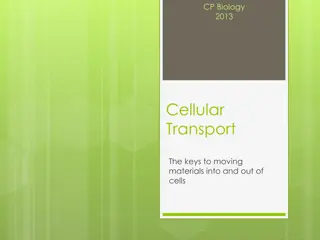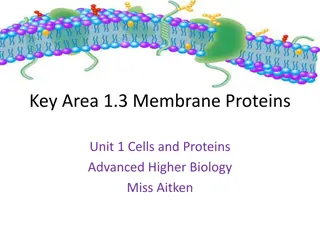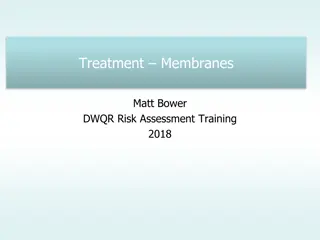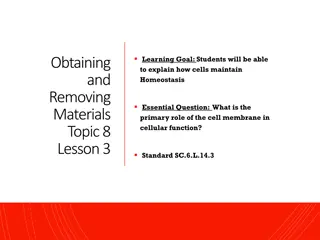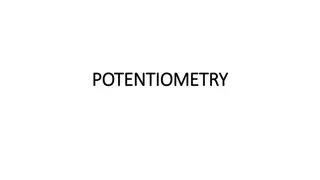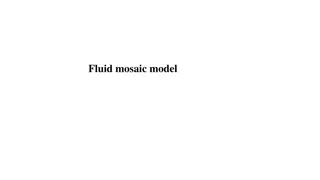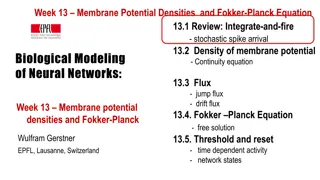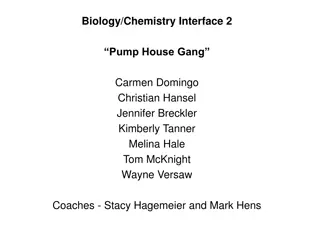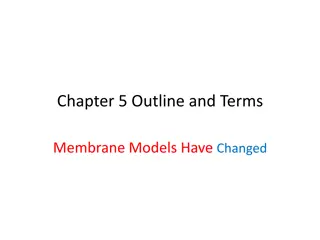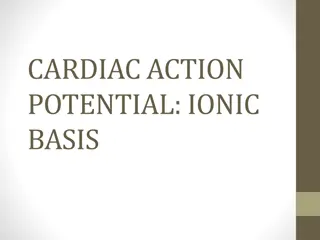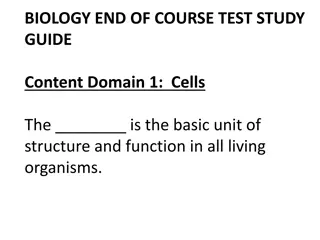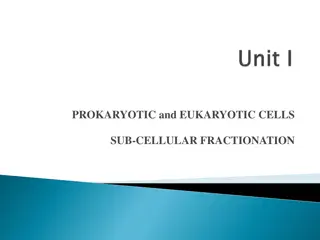Understanding Resting Membrane Potential and Excitability in Cells
Explore the concepts of resting membrane potential (RMP), excitability in cells, and the electrochemical basis behind them. Learn about the characteristics of excitable and non-excitable tissues, the factors influencing RMP, and the role of ion distribution in generating the negative charge inside cells. Unravel the complexities of ion channels, pumps, and the contributions of various ions to maintain cellular homeostasis.
Download Presentation

Please find below an Image/Link to download the presentation.
The content on the website is provided AS IS for your information and personal use only. It may not be sold, licensed, or shared on other websites without obtaining consent from the author. Download presentation by click this link. If you encounter any issues during the download, it is possible that the publisher has removed the file from their server.
E N D
Presentation Transcript
9 2 Notes Notes zz Resting Membrane Potential Editing File 1
Objectives Explain why some membranes are excitable. Describe the electrochemical basis of RMP. Describe the role of myelination & how nerve fibers are classified.
Non-excitable Tissues Excitable Tissues Excitable tissues: tissues which are capable of generation and transmission of electrochemical impulses along the membrane. Non-excitable tissues: tissues which are NOT capable of generation and transmission of electrochemical impulses along the membrane. More negative RMP (-70 to -90 mV) Less negative RMP Examples: Examples: Nerve RBC -8.4 mV Skeletal muscles Epithelial cells -53 mV Cardiac muscles Adipocytes -58 mV Smooth muscles Fibroblasts -20 to -30 mV Intestinal cells
Membrane Potential Resting Membrane Potential (RMP): a potential difference that exists between the inside and the outside of the membrane during rest,across all cell membranes. RMP is about -70 to -90 mV. + + + + + + + + + + RMP is measured using microelectrodes and oscilloscope (voltmeter). Inside is negative with respect to the outside. RMP is the default state of the cell. It corresponds to the sum of all diffusion potentials of extracellular and intracellular ions.
Resting Membrane Potential (RMP) Video Video Important slide , Why is the cell negative inside? Factors contributing to negative RMP: RMP depends on (Factors): 1 One of the main factors is K+efflux (K+leak channel - Nernst potential: -94 mV). 1 Ionic distribution across the membrane 2 Contribution of Na+influx is little (Nernst potential: +61 mV). 2 Membrane permeability 3 Na+/K+pump creates additional degree of negativity inside the membrane (-4 mV). 3 Na+/K+) ATPase pump 4 Negatively charged protein ions remaining inside the membrane contributes to the negativity. Require ATP to diffuse outside the cell. Net Result: -70 to -90 mV inside. 439 note: *Nernst potential = Equilibrium potential Efflux = Exits the cell Influx = Enters the cell 100 potassium efflux while 1 sodium influx causing the positive charge to decrease while the negative charge increase due to the increasing of electrons inside and the decreasing of proteins outside the cell.
Ionic Distribution The Charge of the Cell Causes of the -ve charge of the cell Major Ions Extracellular Ions Intracellular Ions K+leak channel outflux (main reason) Large molecules Protein - RNA - DNA Na+/k+Pump Na+ Cl- K+ Proteins Cell membrane ( . Enter the cell in small quantity. Exit the cell in large amounts. - ) Because it s from high concentration to low concentration there s no need for any pump (so no energy needed). Restating the Previous Slide
In Male Slides Only Electrochemical Gradient Electrochemical Equilibrium An exact balance between 2 opposing forces. Electrical Driving Force Chemical Driving Force Opposing electrical gradient that increasingly tends to stop the ion from moving across the membrane. Chemical driving force: ratio of concentration on 2 sides of membrane (concentration gradient). The concentration gradient that causes the ion to move from area of higher conc to area of lower conc. Electrical driving force: potential difference across membrane. Equilibrium: when electrical driving force is balanced by chemical driving force.
In Male Slides Only Chemical & Electrical Driving Forces of Potassium (K+) 1 K+concentration intracellular is higher. Chemical Forces 2 Membrane is freely permeable to K+. 3 There is an efflux of K+to ECF. Efflux of positive ions creates positivity outside & negativity inside. 4 Electrical Forces Outside positivity resists efflux of K+ (since K+is a positive ion). 5 At a certain voltage, equilibrium is reached and K+efflux stops. 6
In Male Slides Only The Nernst Equation & Nernst/Equilibrium Potential Describes the balance of electrical and chemical forces across a cell membrane that will exactly prevent net diffusion of an ion. Named after Walther Hermann Nernst. Nernst potential(equilibrium potential): potential level across the membrane that will exactly prevent net diffusion of an ion. Ion Na+ K+ Cl- Ca2+ HCO3- Intracellular 14 140 4 0.0001 10 Extracellular 140 4 103 2.4 28 Nernst Potential +61 -94 -86 +127 -27 (mmol/l)
In Male Slides Only The Goldman Equation When the membrane is permeable to several ions, the equilibrium potential that develops depends on: 1 2 3 Ionic concentration Polarity of each ion Membrane permeability This is calculated using Goldman Equation: Using this value in Goldman s equation gives a resting potential inside the membrane of -86 mV.
Na+/K+ATPase Pump Ionic Channels Active transportsystem for Na+/K+ exchange using energy. An electrogenic pump since 3 Na+efflux are coupled with 2 K+influx. Net effect of causing negative charge inside the membrane (-4 mV). Leaky Channels (K+/Na+leak channels) In Resting State: K+permeability is 100 times > than Na+ More permeable to K+ Allow free flow of ions Against its electrochemical gradient, so it requires ATP
A picture that compiles all types of molecules & channels contributing to RMP
MCQs: Q1: The major ion in the resting membrane potential is? A B C D Cl k+ Na+ ca2+ Q2:the resting membrane potential of a large nerve fiber is most likely? A -90 B C D 70 -85 -70 Q3: concentration of Na+ ions in the extracellular fluid is........ mEq/L? 4 10 142 A B C D 85 Q4: overall the net result inside the cell during rest is? A B C D -70 to -90 -85 to -95 -55 to -70 70 to 90 Q5:the Na+/K+ ATPase channel contributes to the overall net charge with? A B C D -55 -70 -4 +4 Answers: 1.A 2.B 3.C 4.A 5.C
MCQs: Q6: the nernst potential of K+ ions is? A B C D -70 +61 +35 -94 Q7: leaky channels are more permeable to? Na+ A B C D Ca2+ K+ Cl- Q8: resting membrane potential of a skeletal muscle cell? -70 A B C D -90 80 -85 Q9: a measuring device for the cell membrane potential? Voltmeter A B C D electricity meter ammeter ohmmeter Q10: all of the following are non excitable tissues except? adipocytes Answers: 6.D 7.B 8.C 9.A 10.B A B C RBC D Epithelial Neuron
Team Leaders Team Leaders Dema Alkhattabi Dema Alkhattabi Waleed Alrashoud Waleed Alrashoud Team Members Team Members Mohammad Alrashed Saud Al-Taleb Sultan Al-Abdullah Saad AlAngri Abdullah Awartani Nouf Aldalaqan Farah Alqazlan Masheal Alasmri Amani Alotaibi Maram Beyari Maha Alkoryshy Nouf Aldhalaan Othman Alabdullah Khaled Bin-Arbeed Rakan Alromayan Talal Alharbi Abdullah AlShehri Special Thanks to Physiology Team441 Special Thanks to Physiology Team441 Physio442@gmail.com Physio442@gmail.com




